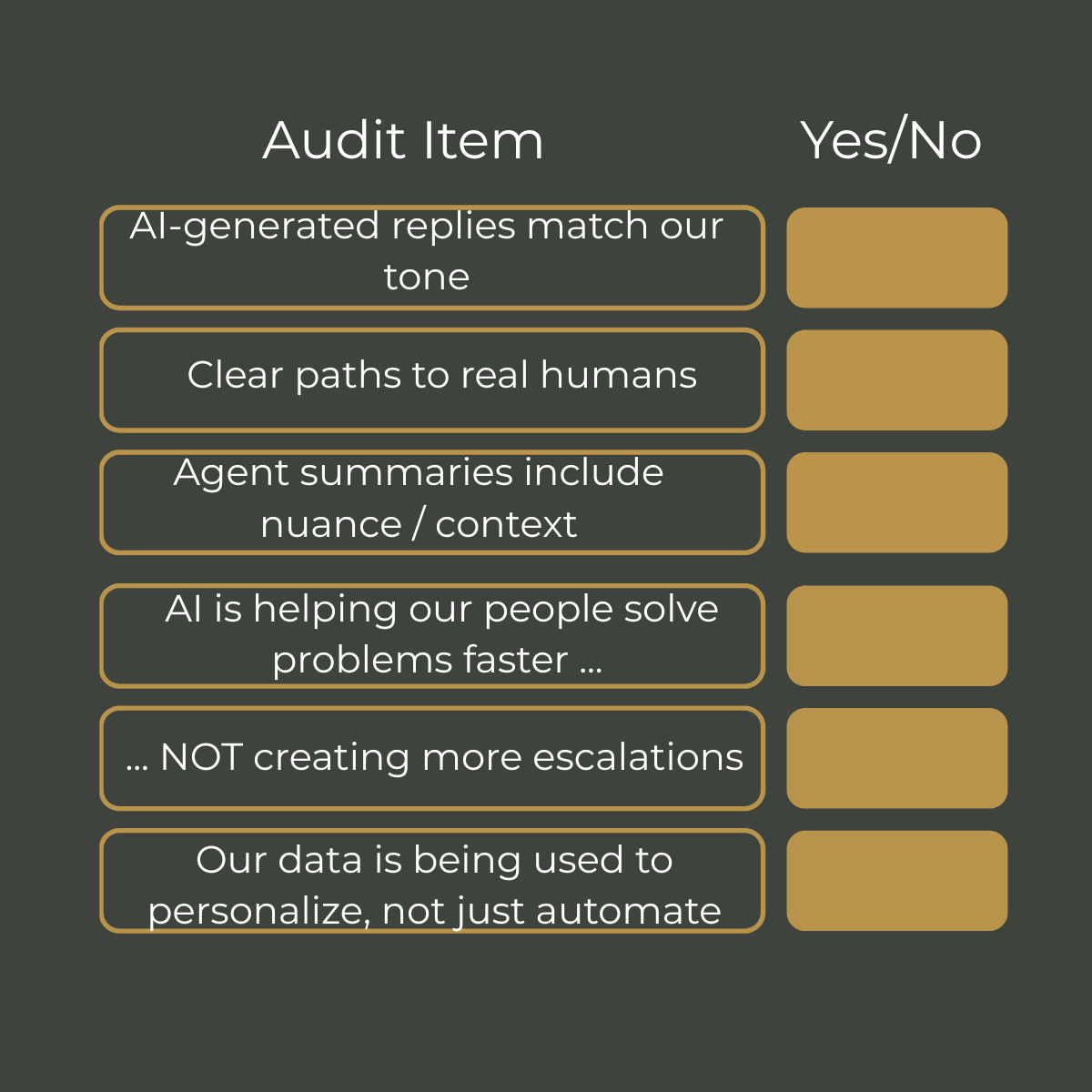Robot Love?

If you need a soundtrack, you can start here:
Let’s be honest — AI is here, and it’s here to stay. Salesforce’s latest release is packed with tools designed to improve speed, accuracy, and productivity across service teams. And while features like Einstein AI and auto-generated replies are enticing, they’re only as good as the human-centered strategy behind them.
Truth is - no amount of automation can replace the impact of a thoughtful, responsive, real human being. As a customer, you know this. How many times do we pound the "0" button desperately trying to get to someone who can actually help us. ANYONE.
So where's the real win?
Blending AI with empathy — intentionally designing your service flows to let tech do the heavy lifting while your people deliver the actual experience.
In this newsletter, we’ll walk through:
Some of the new stuff in Salesforce Service Cloud
The risk of going “AI-first”
3 ways to blend automation with empathy
A human-centered audit checklist
A quick real-world case story
What’s on offer for Salesforce Service Cloud? Salesforce has improved their options for AI-powered service support, including:
🐾 Einstein for Service
Salesforce’s AI assistant can:
Suggest replies based on customer history
Auto-summarize long case threads for agents
Recommend next steps
🐾 Work Summarization
AI can summarize previous client / support interactions for cases — this means support gets faster context without scanning every previous case log. This is beneficial at every level of support, whether it's shift change at tier 1, pickup at tier 2, or an escalation.
🐾 Enhanced Omni-Channel Routing
Routing can be based on sentiment, urgency, and case complexity —improving the timing on human intervention.
These tools are smart, scalable, and powerful — but most valuable when paired with a thoughtful implementation plan.
⚠️ The Risk of AI-First Without the Human Layer
When we're running around trying to do all-the-things, the temptation is real to just let the bots handle it.
But here's the problem. When AI becomes your frontline instead of your assistant, customer trust starts to erode. We’ve all been there — stuck in a chatbot loop, feeling unseen, unheard, and frustrated…probably yelling at robots.
In service-based businesses where relationships matter, that’s a serious risk.
What I tell clients often: AI shouldn’t replace your team. It should enhance them.
🧠3 Ways to Blend Automation with Empathy
Here’s how I guide clients through building AI-enhanced, human-first service systems:
1. Train Your AI to Match Your People
Most AI systems (including Salesforce’s Einstein) can be customized to match the tone of your brand. Don’t settle for default replies — teach your AI how your team talks.
Use real agent responses as training data
Include tone guidelines in prompt customization
Inject warmth and simplicity, especially in stressful moments
This tiny shift builds trust fast.
2. Set Smart Escalation Triggers
Not every case should be handled entirely by AI - don't we as customers know it!!!
Set clear criteria that immediately hand off to a human — like:
Emotional keywords (angry, upset, cancel, and…others we won't print here)
Repeat contacts on the same case
Long response chains
VIP accounts
Let AI triage, not trap.
3. Review AI Transcripts Weekly
If you’re letting bots speak on your behalf, review what they’re saying.
Create a weekly QA ritual:
Spot-check AI replies for tone mismatches, erroneous routing, etc
Track escalation counts on cases
Compare customer sentiment before and after AI interaction (read: case surveys)
Weekly checks protect long-term customer experiences
✅ Human-Centered Audit Checklist
Do a quick review of your AI setup:
If you scored more “no” than “yes,” you’re not alone — but you do have a huge opportunity.

🧭Mini Case Story: From Script to Supportive
One of my clients was using reply suggestions and automated summaries to manage their increasing service load. But customer satisfaction started dropping.
Reviewing cases helped us uncover:
AI responses were technically accurate, but emotionally cold
Routing to humans was being delayed due to missed intent pairings
Agents were either skipping personalization because AI was or their documentation was slipping - either way, coaching needed to happen
We improved responses to include friendlier phrasing, improved routing pairings, and implemented stronger QA that included weekly review meetings
The result?
🐾 CSAT improved by 18%
🐾 Escalations dropped by 23%
🐾 Customers started mentioning agent names again (and in a positive manner!)
Final Thoughts: Real People Still Win
AI can be an amazing force — but people build relationship and loyalty.
The smartest Salesforce setup is one that amplifies your team’s empathy, clarity, and responsiveness, not one that hides them.
If you’re looking to optimize your service experience without losing the human part, I can help. Whether you need a fresh implementation, a fractional strategy partner, or an outside eye on your existing system — you don’t have to do it alone.
💡 Let’s Make AI Work For You — Not Instead of You. Reach out, we'd love to help.
Created with © systeme.io


